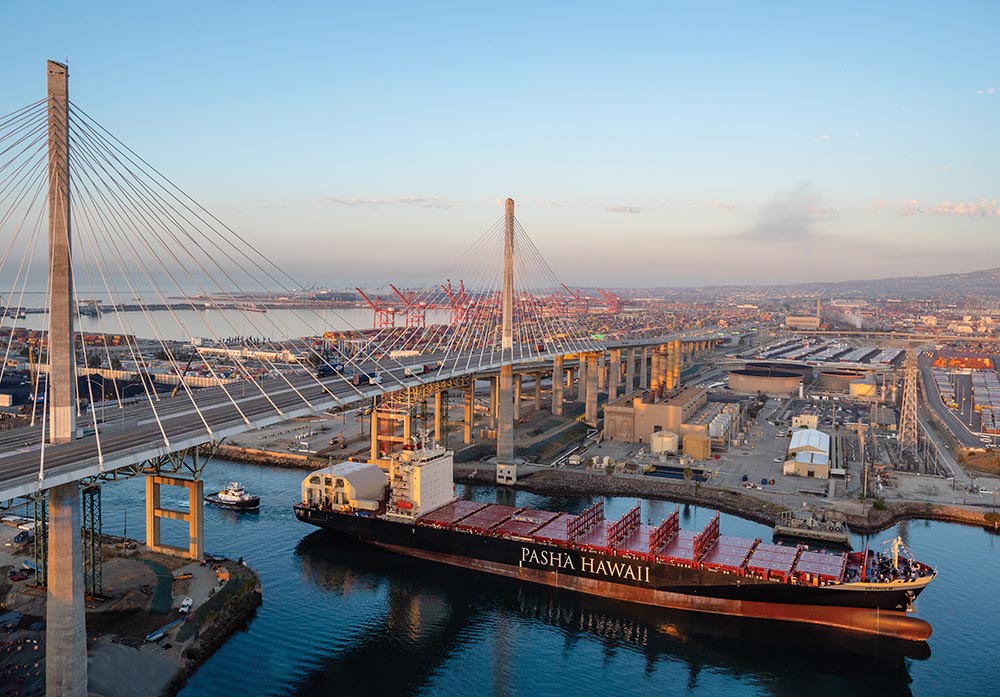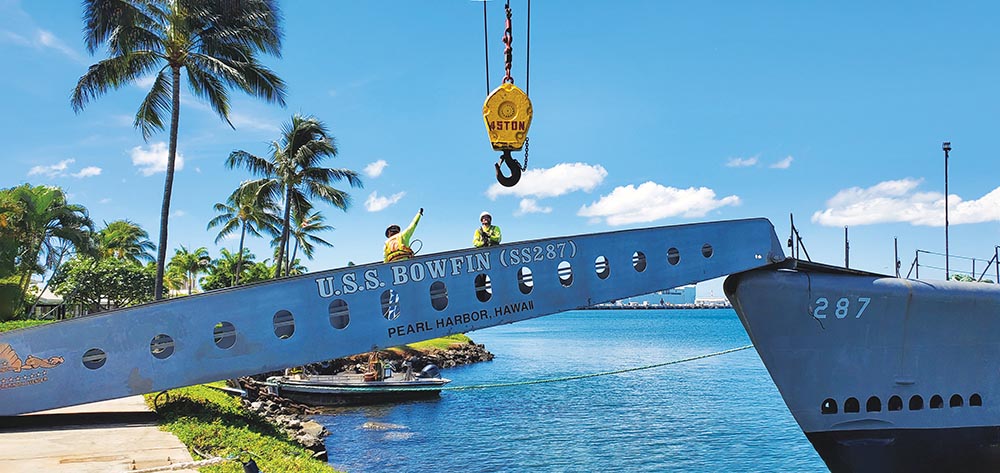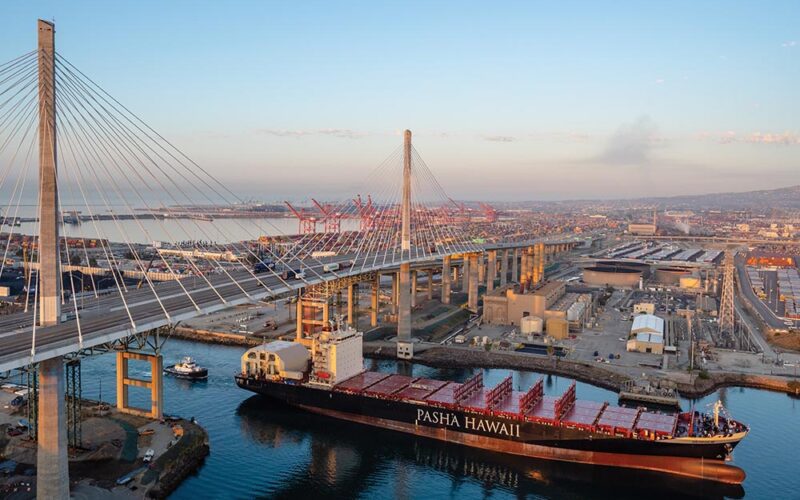
As the global economy continues to emerge from the COVID-19 pandemic, maritime firms remain steady in their investment in Alaska and Hawaii.
Whether they’re upgrading vessels and/or building facilities and other infrastructure, companies and public agencies in the region are working on various initiatives and projects to cement their footing in the two states and bring opportunities to far-flung communities.
Here’s a sample of what some companies and other entities are up to in the Alaska and Hawaii region:
PASHA
Business is going well across the board in the Hawaii/Mainland trade lane, said George Pasha IV, president and CEO of Pasha Hawaii.
“Hawaii’s economy has rebounded from the effects of the pandemic at a faster rate than the broader U.S. as a whole,” Pasha IV said. “The return of international tourists is a welcomed sign as Hawaii’s tourism industry accounts for roughly 20% of Hawaii’s economy. Other sectors such as construction and the military have remained pretty consistent and we are seeing good growth signs into 2023.”
On Aug. 17, Pasha Hawaii welcomed the first of two new ‘Ohana Class containerships. m/v George III, named after Pasha IV’s father, started her maiden voyage soon after from Long Beach to her Honolulu homeport. The George III, which sails between the Port of Oakland, the Port of Long Beach and Honolulu as part of the company’s bi-weekly service to the three locations, is the first liquefied natural gas (LNG) powered vessel to fuel on the West Coast, and the first to serve Hawaii.
“The new 774-foot Jones Act vessel surpasses the International Maritime Organization (IMO) 2030 emission standards for ocean vessels, representing the most technologically advanced and environmentally friendly vessel to serve Hawaii,” Pasha IV said.
The company plans to welcome its second ‘Ohana Class vessel, named m/v Janet Marie after Pasha IV’s mother. The vessel will also run on LNG from day one and will mirror George III in size and design, Pasha said.
“This year marks our company’s 75th anniversary,” Pasha IV commented. “The launch of our ‘Ohana Class vessels and the recognition we received as the No. 1 one ocean carrier (from an industry publication and Peerless Research Group) was the perfect way to mark this incredible milestone.”
Meanwhile, Pasha Hawaii has been engaged in a series of ongoing projects. Its containership Reliance is being retrofitted to operate on liquified natural gas and is expected to re-enter service in the first quarter of 2023. This project, as well as the launch of its ‘Ohana Class vessels, continues to move forward as expected, Pasha said.
Also on schedule is the highly anticipated construction of the new Kapalama Container Terminal on Oahu.
The $50-million public/private collaboration between the state of Hawaii, Hawaii Stevedores and the Pasha Group (the parent company for Pasha Hawaii and Hawaii Stevedores) continues to make progress with an expected completion date of the first quarter of 2024.
On March 1, 2021, Phase I was completed and the official groundbreaking for Phase II took place.
Through the use of technology and design, KCT is expected to serve as one of the state’s most efficient operating terminals, Pasha said.
He added that incorporating an on-dock container-to-barge operation is expected to eliminate more than 50,000 truck moves from local streets and highways for neighbor-island transfers.
“When completed, KCT will significantly improve cargo handling productivity and capabilities, serving as the future home for Pasha Hawaii’s sister company, Hawaii Stevedores,” Pasha said.

AMERICAN MARINE CORP.
American Marine Corp. (AMC), a longtime West Coast company, has a presence in Alaska and Hawaii. The most recent work performed by its crews this year showcases the company’s marine contracting, commercial diving and vessel-support services.
The company, which has offices in Anchorage, Los Angeles and Honolulu, has been working on various trans-Pacific subsea cable installations. Crews also have replaced and repaired subsea oil and gas pipelines and infrastructure, conducted diving inspections and upgraded infrastructure in the Port of Alaska and the Port of Honolulu, AMC Executive Vice President David Shahnazarian said.
One of the bigger endeavors for American Marine is the Port of Alaska Modernization Cathodic Protection Installation project with Pacific Pile and Marine. Pacific Pile hired AMC to install the subsea cathodic protection system for the port. The work involved using its specialty Cook Inlet Diving Service Vessel Shamrock and putting in a dozen 15,000-pound anode sleds, multiple collar anodes on various pilings and multiple fender anodes to safeguard the dock fender system from corrosion.
Crews had to perform that work amid 30-foot tidal changes with zero visibility and currents up to seven knots.
“This was a critical project for the state of Alaska to protect the investment in upgrading the port infrastructure and capabilities,” Shahnazarian said.
In Hawaii, American Marine worked on a number of projects, which included quickly responding to a sinking 35-foot sailboat that was not only leaking oil and fuel, but was blocking the only entry point into Honolulu Harbor for freight movers, fishing and cruise ships.
AMC, whose divers did the work at night with zero visibility, was able to remove the sailboat within eight hours of a call from the Hawaii Department of Transportation’s Harbors Division, according to AMC Hawaii Vice President Michael MacDonald.
This year, American Marine Corp. was selected by Pacific Shipyards International to tow the 80-year-old World War II submarine USS Bowfin from its mooring at the USS Bowfin Submarine Museum and Park in Pearl Harbor to its dry dock in Honolulu Harbor. MacDonald said the company was proud to be entrusted with this work.
“The tow was an extremely technical operation that required the use of multiple American Marine resources,” he said, adding that the company’s 100-ton floating crane barge AMC 160 was used to remove the tourist access ramp and chain moorings.
AMC divers assisted in the removal of four chain moorings and tugs American Champion and American Emerald towed the USS Bowfin on the five-hour trip to the dry dock.
LYNDEN
Known in the industry for offering transportation and logistics solutions in North America and beyond, the Lynden family of companies, which include barge service providers Alaska Marine Lines and Aloha Marine Lines, has had a busy 2022.
Over the past year, Lynden’s companies have worked on various projects in the Hawaii and Alaska regions.
For example, Lynden Transport in June made the last delivery of a year-long SpaceX project in Alaska—7-foot by 9-foot, 3,000-pound antennae, pieces that needed placement by forklift onto trailers.
Over the past year, about 27 units had to be delivered by truck, steamship and barge to various locations in Alaska as part of a global installation of satellites.
In Hawaii, Aloha Marine Lines was tapped in March to move two large tour boats for the Pacific Whale Foundation, which involved moving the two vessels by crane off the barge at Barbers Point Harbor on Oahu.
Meanwhile, Lynden continues to lean into both regions. Several years ago, Aloha Marine Lines increased its cargo capacity to Hawaii by 35% with the purchase of two high-capacity barges, the Kamakani and Namakani, according to Alaska Marine Lines and Aloha Marine Lines sales director Bret Harper.
At 438-feet long and 105-feet wide with a deadweight capacity of 16,869 tons, both barges are fitted with 22-foot-high cargo binwalls, which help to keep freight secure while minimizing the amount of lashing needed for each voyage.
“We just recently repainted the Namakani, and it’s great to see our traditional green and yellow colors sailing past Honolulu,” Harper said, adding that the barges often carry building materials that support projects such as lumber, roofing materials, pipe and structural steel, as well as tower cranes and over-dimensional cargo.
To meet customer needs, Lynden has been modernizing its processes and equipment, including offering 102-inch wide, 53-foot long containers and platforms.
“The extra width and height provide increased cubic capacity to make shipping more efficient, and they have proven very popular on our Seattle-to-Hawaii route,” Harper said. “We also feature Kaptive Beam decking systems that allow freight to be stacked higher in the container without crushing the bottom pallets, so space can safely and efficiently be maximized.”
Lynden has also been investing in technology such as its mobile app, which helps customers get up-to-date shipment information while working remotely or on a project site. Clients can sign up to receive email updates as their shipment status changes, so they will always know when to expect the next load of supplies needed for their project or business operations, Harper said.
That mindset of helping customers do business easier proved especially valuable when the COVID-19 pandemic hit the supply chain.
“The supply chain crisis has taught us that, more than ever, flexibility is key,” Harper said. “We are taking this opportunity to work with customers to re-engineer their transportation and logistics plans up and down the supply chain. With advanced inventory planning, some products or supplies may be able to be moved by a different mode or routing than they are currently using.”
That means offering multi-modal solutions to provide customers ultimate flexibility and building logistics plans that use combinations of air, land and sea options to give customers the best balance of time and cost, he added.
Many of the supply chain issues that disrupted 2021 continue to be felt this year, Harper said. “This includes equipment being tied up at ports and in many supply chains around the globe, resulting in a lack of equipment available for customers to use,” he said. “For Alaska’s seafood industry this is critically important, as equipment must be ready and available to fully take advantage of the peak fish runs during the summer.”
Even in a normal year, Harper said, the industry is often at the mercy of Mother Nature, and it’s not fully predictable when and where products will be available for harvest. Variances in fish run locations and timing, bad weather and locally imposed quotas can cause volumes to fluctuate dramatically from year to year.
To help support the seafood industry, and to mitigate equipment availability issues, Lynden purchased additional refrigerated shipping containers primarily for transporting seafood products from Alaska.
“These arrived just in time to support this year’s record Bristol Bay sockeye harvest,” Harper said. That harvest totaled nearly 59 million sockeye as of late July, beating the prior record of 44.3 million fish.
The containers are the latest in efficient refrigerated operations, featuring temperature-controlled software that can vary the fan speed and control compressors to match the conditions and current cooling demand.
“That translates into a power draw one-fifth that of older containers,” Harper said. “Less power required to run the reefers means fewer generators running, less fuel consumption and lower carbon emissions.”
HAWAII DOT
In November 2021, the Hawaii Department of Transportation dedicated the new Harbor Police Building, a $5.23-million project that turned the former fire station at Pier 15 into the new Harbor Police headquarters.
The relocation and renovation project, funded with harbor revenue, also will help diversify the police force while adding a classroom training center, according to the agency.
“This facility will support our officers as they carry out their duties as law enforcement support to the maritime industry,” HDOT Director Jade Butay said at a blessing ceremony for the new building. “The Pier 15 location will allow easy access and quicker response to commercial harbor waters.”

